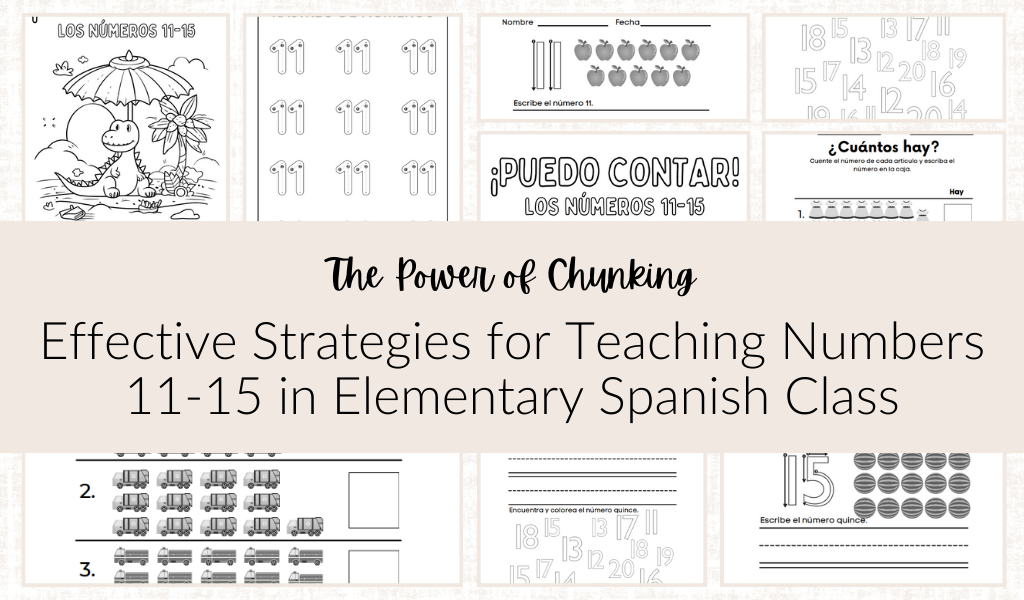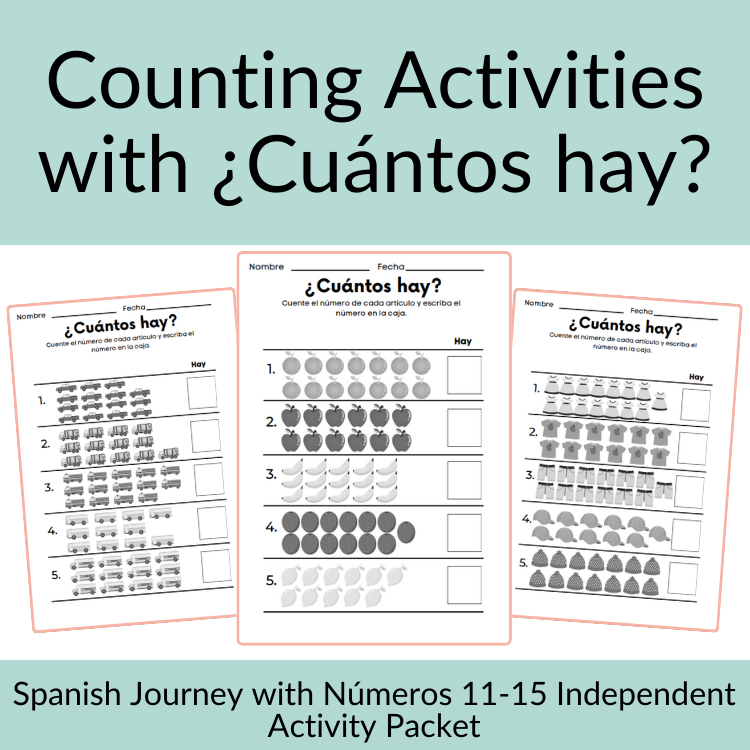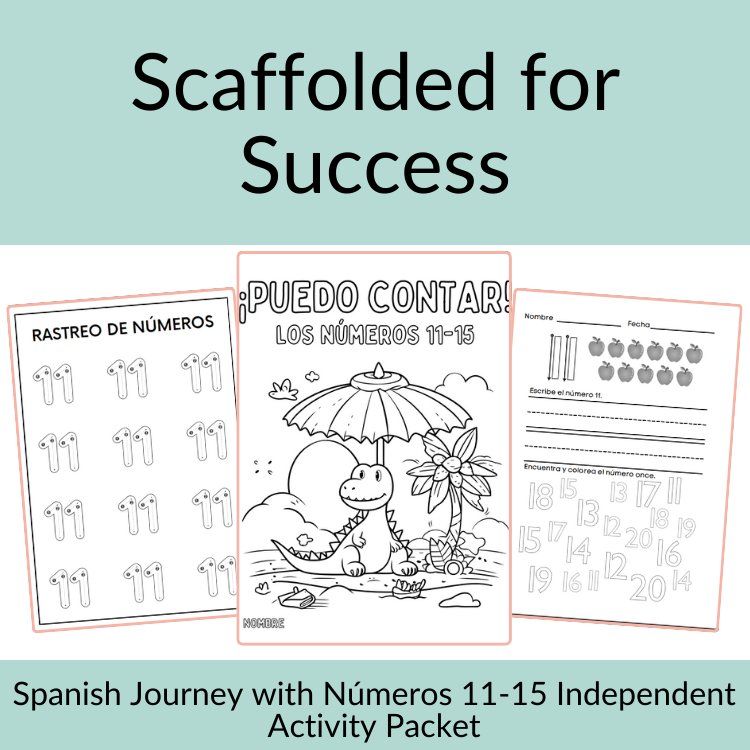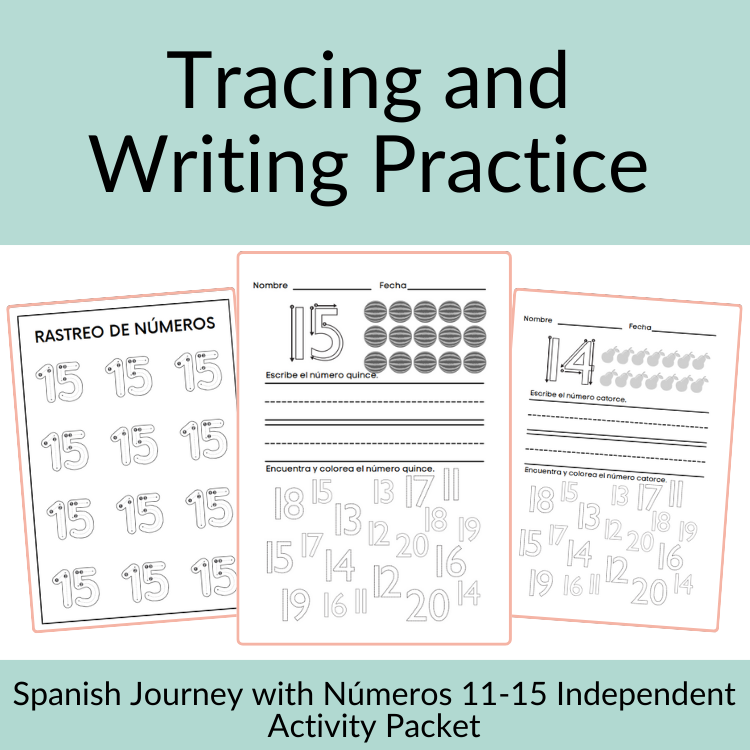When you’re teaching Spanish numbers and phrases to your elementary students, you know that a big phrase like “Tengo doce años” can seem daunting at first. That’s where the magic of breaking it down—or “chunking”—comes into play! Today, we’re going to explore why breaking phrases into parts and then rebuilding them is one of the best ways to help your students learn (backed by science!), using the Spanish Journey with Los Números 11-15 Independent Activity Packet as an example. Plus, I’ll share five fun movement-based games that you can use to reinforce this learning and keep your students excited.
The Power of Chunking: Why It Works for Your Students
Chunking is a fancy term for breaking down information into smaller, bite-sized pieces to make it more digestible. When you teach phrases like “Tengo quince años,” your students are more likely to retain and feel confident using these phrases if you break them down first. Let’s see why this method is effective—and backed by research.
Why Chunking Works for Your Students:
- Reduces Cognitive Load: Kids’ working memory has limits, especially when they’re learning a new language! By chunking phrases like “Tengo” (I have), “doce” (twelve), and “años” (years), we reduce the mental effort required. Cognitive science shows that breaking tasks down like this makes it easier for learners to process and remember new informationdence:** Every time students successfully master one small chunk, they feel a sense of accomplishment. By focusing on individual parts, like tracing numbers first in the Los Números 11-15 packet, students are able to gradually rebuild the full phrase with confidence. ¡Claro que sí!
- Strengthens Pattern Recognition: Your students will begin to see how numbers fit into different phrases, helping them predict future patterns. For example, they’ll quickly realize that “Tengo quince años” is simply the same pattern as “Tengo doce años,” just with a different number plugged in. Neuroscience backs this up—recognizing patterns helps the brain create efficient connections .
The Do’s of Phrase Building:
- Do Start Small – Teach each part of the phrase separately. For example, start with tracing and saying the number first (“once”) before expanding to the full sentence “Tengo once años.” Baby steps!
- Do Use Visuals – Visual learners will thrive with pictures or props. Show images of birthday cakes or age-related objects as they say “Tengo catorce años.” This ties meaning to the words they’re learning.
- Do Rebuild Gradually – Once your students are comfortable with each part, challenge them to piece it back together. Guide them to plug in the number they’ve mastered: “Tengo __ años.”
- Do Encourage Speaking Practice – Encourage speaking out loud! Repetition, both written and spoken, solidifies the phrase in your students’ memory. Have your students recite the phrase as they work through the packet, reinforcing both writing and oral skills.
- Do Celebrate the Wins – Learning a language is no small task! Celebrate each step—whether it’s saying “quince” or the full “Tengo quince años.” Positive reinforcement will motivate your students to keep going, especially when they see their progress.
The Don’ts of Phrase Building:
- Don’t Rush the Process – Rushing overwhelms your students. Let them take their time with each part of the phrase before moving on. Slow and steady wins this race!
- Don’t Overload with Too Much Information – Less is more! Stick to one phrase structure, like “Tengo __ años,” in a lesson before introducing more complex ones. Overloading can cause cognitive fatigue, which makes it harder to retain information.
- Don’t Forget About Visual and Kinesthetic Learners – Some kids need to see it, and others need to move with it. Add gestures, props, or movement to help reinforce the meaning of each chunk.
- Don’t Skimp on Repetition – Consistency is key. Make sure to repeat the phrases in a variety of ways—written, spoken, and even sung!
- Don’t Forget Fun! – Keep the energy up with games, movement, and plenty of smiles. Learning is most effective when it’s enjoyable.
Get Your Resource: Spanish Journey with Números 11-15 Independent Activity Packet
5 Fun Movement-Based Games to Reinforce Numbers & Phrases
Now that your students have chunked and rebuilt their phrases, it’s time to make it fun! Here are five movement-based games to use after completing the Spanish Journey with Los Números 11-15 activity packet. These games will reinforce the phrases while keeping your class active and engaged.
- Cumpleaños Mágico (Magical Birthday)
Students decorate “birthday cakes” with the number of candles that matches their age. Then, they walk around the room asking their classmates “¿Cuántos años tienes?” and answering in full sentences like “Tengo doce años.” This activity combines creativity, movement, and phrase repetition! - Frase Voladora (Flying Phrase)
Hide index cards around the room with parts of the phrase written on them (like “Tengo,” “quince,” and “años”). Students have to find the parts and race to put them together correctly. It’s a scavenger hunt with language practice built in! - Salta y Cuenta (Jump and Count)
Set up stations for each number (11-15). Call out a number, and have students jump to that station while shouting the full phrase: “Tengo catorce años!” This activity combines physical movement with repetition and phrase practice. - Pasa la Frase (Pass the Phrase)
Students sit in a circle and pass a ball. Each student says one part of the phrase: “Tengo,” “once,” “años.” This game strengthens listening, speaking, and teamwork—all while keeping it fun! - Ritmo de Frases (Phrase Rhythm)
Have your students use clapping, stomping, or maracas to match the rhythm of their phrases. For example, they clap and say, “Tengo… catorce… años.” This activity adds a musical, rhythmic element to language practice, which is great for auditory learners.
Best of all, the fun doesn’t stop! Be sure to check out the full set of presentations that scaffolds students all the way up to the number 20, available now in the Joyful Journey in Langauge Learning TPT shop! 🎉
Spanish Journey with Los Números 1-5 Digital Presentation
Spanish Journey with Los Números 1-5 Independent Activity Packet
Spanish Journey with Numbers 6-10 Digital Presentation
Spanish Journey with Los Números 6-10 Independent Activity Packet
Spanish Journey with Numbers 11-15 Digital Presentation
Spanish Journey with Números 11-15 Independent Activity Packet
Spanish Journey with Numbers 16-20 Digital Presentation
Spanish Interactive Counting & Tracing Numbers 0-20: A Complete Resource
The Gist of it All
Chunking phrases into smaller parts and then rebuilding them helps your students understand and retain new language more effectively. It reduces cognitive load, builds confidence, and taps into pattern recognition—all backed by neuroscience. With fun, movement-based games like Cumpleaños Mágico and Frase Voladora, you’ll keep your class engaged and excited about learning. Remember, breaking it down and keeping it fun is the key to success!
I hope you find these tips and games helpful, Joyful Journey Makers! Let me know which game your students loved the most, and don’t forget to check out my Spanish Journey series for more engaging classroom resources.

Resources
Baddeley, A. D. (2003). Working Memory and Language: An Overview.
Gobet, F., & Lane, P. C. R. (2012). Chunking Mechanisms in Human Learning.
Willis, J. (2011). The Neuroscience of Joyful Education.




